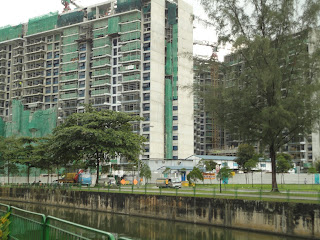Jurong Lake
Jurong Lake is located amid the densely populated Jurong new town, next to the Chinese Garden MRT station in the western part of Singapore. Before it was developed, Jurong was a mangrove swamp with some plantation farms, fish and prawn ponds and crocodile-infested rivers. The area was developed into an industrial estate in 1961. Residential and recreational amenities were built in the next two decades to attract workers and to facilitate the expansion of the estate. Jurong Lake was formed with the damming of Sungei Jurong further downstream. Jurong Lake is now a fresh water lake and reservoir.
Map of Jurong Lake
Our task was to compare the water samples from 2 parts of Jurong Lake. Using data loggers, the following data on the water samples were collected at 2 different points of Jurong Lake; the Jurong Lake Platform (“JLP”) and the Jurong Lake Canal (“JLC”) on 16 July 2013 at around 1530hours.
Jurong Lake Platform
|
Jurong Lake Canal
| |
Air temperature (Celsius)
|
28.4
|
30.3
|
Water temperature (Celsius)
|
29.8
|
33.6
|
Acidity (pH)
|
7.77
|
8.22
|
Dissolved oxygen (mg/L)
|
6.77
|
6.52
|
Turbidity (NTU)
|
13.5
|
15.5
|
Salinity (µS/cm)
|
0
|
0
|
Other Test undertaken
A bacterium test was done in the school laboratory on the samples of water taken from JLC and tap water.
A bacterium test was done in the school laboratory on the samples of water taken from JLC and tap water.
Data Analysis
The air temperature was slightly higher at JLC than JLP. This could be because the temperature taken at JLC was before a rainstorm and the temperatures taken at JLP was when the rain just started and the surroundings started to cool.
The water temperature was also warmer in JLC (33.6C) than JLP (29.8C) which indicate that the water quality from JLP is better than JLC. In fact, with such a reading, the water in JLC can be considered polluted.
The acidity levels of both places were within the Good pH range (6-9) which is optimum for growth and health for most aquatic organisms.
Checking on the oxygen levels in the water, the water from JLP (6.77mg/L) is considered slightly polluted whilst the water from JLC (6.52mg/L) was almost reaching moderately polluted range.
Obviously, water from both places were not fit for direct consumption as their Turbidity levels were both above that of Drinking water (<5NTU). Water from JLC (15.5NTU) is slightly more turbid than that from JLP (13.5NTU).
Both sources of water displayed the same Salinity levels (0 µS/cm) which are equivalent to those of fresh water.
The overnight bacterium test conducted at school for the water from JLC and tap water showed twice as much bacteria in the JLC sample compared to the tap water.
Other Observations
Small canal fishes and water spiders were seen in the JLC. There were also dried leaves and twigs floating in the canal.
The colour of the water in JLC is greenish and there is a plastic odour emitting from it. Plastic bottles, plastic bags, toothpicks and other litter were found floating in the canal. Along the side of the canal, there are also other litter like tissue paper, cotton buds and plastic litter.
The canal runs along the bicycle and jogging track. Not far off is the main road where the bus stop is located and the MRT station and flats are also in the vicinity. This resulted in a steady stream of people passing by the canal. At one part of the canal, there were blocks of apartments under construction within thirty metres from the canal. In the evenings, there were joggers, cyclists and families enjoying their activities along the canal path and in the lake areas.
Pedestrian traffic near the canal
Conclusion
The water in Jurong Lake Canal is more polluted than the water in Jurong Lake Platform.
The pH and Turbidity levels are higher in JLC and its dissolved oxygen level is lower as compared to JLP. The water temperature in JLC is also warmer than in JLP. There is also twice as much bacteria in the JLC water than normal tap water.
Further proof of the pollution in JLC can be seen from the litter floating in the canal and along the side. This is mainly due to the recreational activity near the canal and its proximity to the neighbourhoods. Litter, especially plastic litter is non-biodegradable and will pollute the water and cause harm to the living organisms in the water.
With a large construction site next to the canal, it is also likely for dust and construction materials like cement to get into the canal. Surface water run-off also carries pollutants from the site, such as diesel and oil, toxic chemicals into the canal. When these substances get into the waterways and poison water life and any animal that drinks from them.
It is important to care for our water resources and ensure the cleanliness and health of our waterway networks. Singaporeans are encouraged to take joint ownership of water by using it wisely and keeping our waterways, waterbodies and catchment areas clean.





